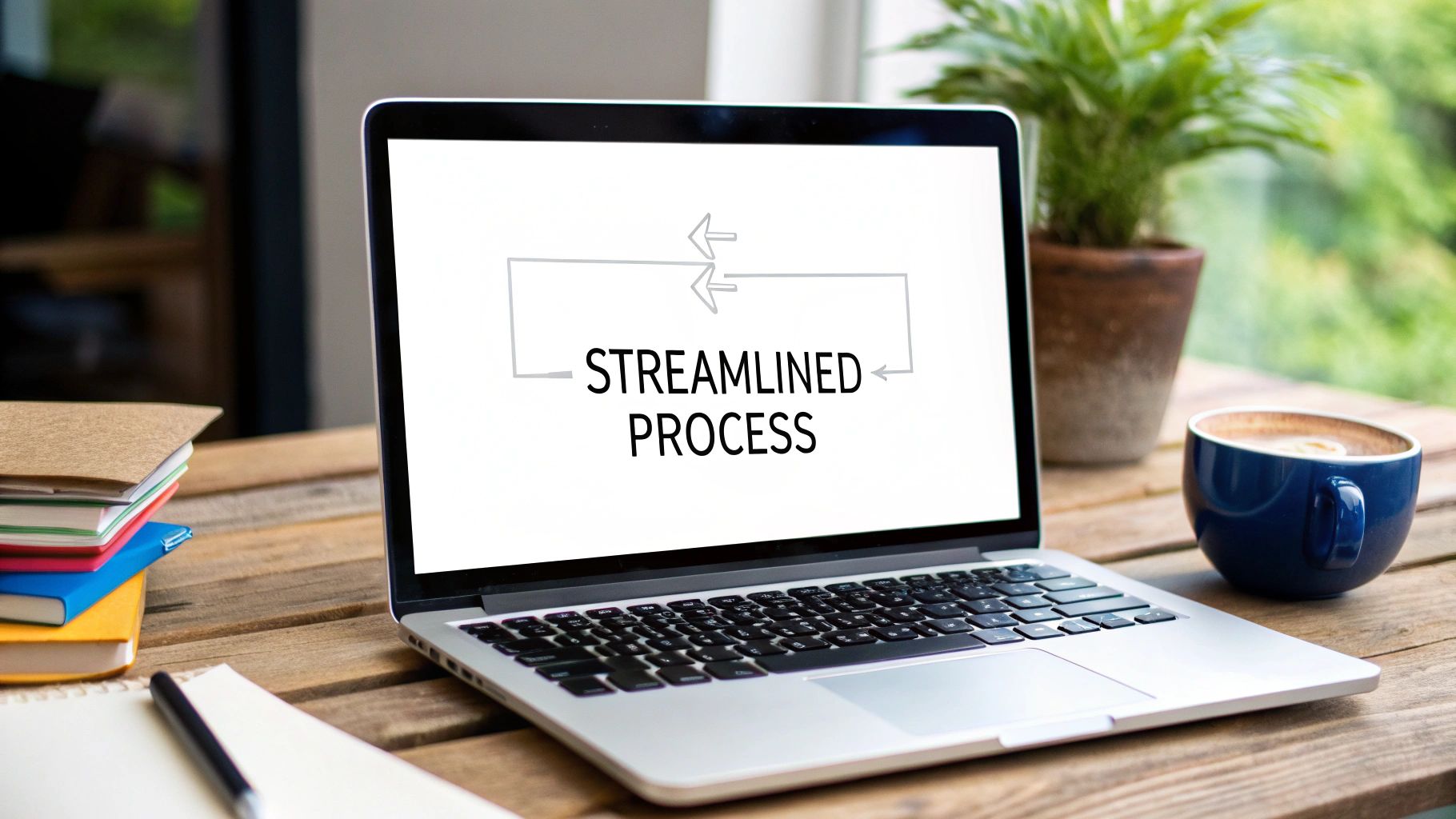Batch Video Compression: Pro Tips for Speedy Results
The Evolution of Batch Video Compression

Batch video compression is a fundamental part of how we work with video today. But it wasn't built overnight. It's the product of decades of improvements in video compression technology, starting long ago with analog video, where the initial ideas about compression first appeared. Knowing this history helps us appreciate how powerful and efficient today's batch processing tools really are.
The story of video compression began as early as 1929 with proposals for analog video compression. Over time, different compression methods and standards were developed to make compression better. A major step forward happened with motion-compensated DCT video compression in the late 1970s and early 1980s. This technique became the core of modern video compression standards.
A key example is H.261, the first successful digital video coding standard, released in 1988. H.261 used both intraframe and interframe compression, setting the stage for future progress. Now, batch video compression uses these advancements to handle huge amounts of video. Modern codecs like H.264 and H.265 deliver high-quality video at smaller file sizes. Learn more about this history here.
From Analog to Digital: A Paradigm Shift
Moving from analog to digital video compression was a huge change. Analog compression methods had limitations. Digital compression opened up the possibility of much more advanced algorithms and higher compression levels, all while keeping or even improving video quality. For example, digital methods could take advantage of redundancies in the video data, within single frames and between consecutive frames.
The Rise of Modern Codecs
This progress led to the codecs we rely on heavily today, like H.264 and H.265. H.264 offers a good balance of compression and processing power, making it the standard for many uses. H.265, also called HEVC, goes further with even better compression, creating smaller files without sacrificing visual quality. This ongoing development is what makes batch video compression so effective at processing large video libraries.
Choosing the Right Codecs for Your Batch Workflows

Picking the right video codec can be confusing. This guide helps you choose the best codec for batch video compression, explaining the pros and cons of common options. Understanding the balance between compression, quality, and processing time makes your workflow much more efficient.
H.264: The Reliable Workhorse
H.264 is still widely used for batch processing because it's compatible with almost everything and compresses efficiently. It offers a good balance between processing speed and file size, making it ideal when you need results quickly. For example, H.264 is a good choice for web videos and social media content where moderately sized files work well.
H.265/HEVC: The High-Efficiency Powerhouse
H.265/HEVC offers even better compression than H.264, delivering smaller files for the same quality. This makes it great for high-resolution video like 4K and 8K, especially when storage space or bandwidth is limited. The trade-off is that H.265 needs more processing power, potentially increasing batch processing times.
Batch video compression often uses advanced codecs like H.264 and H.265. H.264, released in 2003, provides good quality at lower bitrates using methods like inter-frame compression. H.265/HEVC, a newer codec, is even more efficient, needing about half the bitrate of H.264 for the same quality. This makes it well-suited to high-resolution video. However, H.265 requires more processing power and may have higher licensing costs. Learn more about these codecs on Cloudinary and Compresso's blog post comparing H.264 vs H.265.
Codec Selection Best Practices
There's no single best codec for every situation. The optimal choice depends on your specific batch workflow. Consider these factors:
-
Content Type: For action-packed videos, prioritize quality to minimize artifacts. For static content, higher compression is usually acceptable.
-
Resolution: H.265 excels with high-resolution content where its compression efficiency saves significant storage space.
-
Hardware Resources: If processing power is limited, H.264 might be faster.
-
Delivery Platform: Consider the codec support and bandwidth limitations of where your videos will be played.
Comparing H.264 and H.265
This table summarizes the key differences between H.264 and H.265 for batch compression:
| Feature | H.264 | H.265/HEVC | Impact on Batch Processing |
|---|---|---|---|
| Compression Efficiency | Good | Excellent | Affects file size and storage |
| Processing Speed | Faster | Slower | Impacts overall processing time |
| Hardware Requirements | Lower | Higher | Influences system load |
| Compatibility | Wider | Growing | Determines playback support |
By considering these factors, you can pick the right codec for your batch video compression and balance file size, quality, and processing speed.
Building Bulletproof Batch Video Compression Workflows

Tired of wrestling with slow and inefficient batch video compression? This section explores practical, real-world workflows that get the job done right. We'll look at the techniques production professionals use to keep projects on schedule and clients happy, especially when dealing with large video libraries.
Folder Hierarchy and Naming Conventions
A solid folder structure is the bedrock of successful batch compression. Good organization prevents costly errors and makes the entire process much smoother. For example, separating your original videos, the compressed versions, and your project files keeps things tidy.
Consistent naming conventions are also essential. They simplify file management and allow for automated tracking. Think about including dates, project names, or version numbers right in the file names. Need some practical tips? Check out this helpful guide on how to compress videos using FFmpeg and an easier alternative.
Quality Control Checkpoints
Building in quality checks throughout your workflow catches problems early. This stops small issues from becoming big, time-consuming headaches.
These checkpoints might involve automated scripts that verify things like file integrity and resolution after compression. Visual checks at key stages also ensure you’re maintaining the quality you need. This proactive approach saves time and resources down the line.
Queue Management and Error Handling
When you're working with a lot of videos, managing your compression queue effectively is crucial. This means prioritizing videos, allocating processing power, and tracking progress.
Robust error handling is just as important. A good system automatically logs errors, retries failed compressions, and alerts you to persistent issues. This keeps the batch process running smoothly.
Workflow Diagrams and Common Pitfalls
Looking at real-world workflow diagrams gives you a valuable peek into how the pros structure their batch compression processes. You’ll often find smart automation tricks and efficient ways to allocate resources.
Understanding common pitfalls, even those experienced teams run into, can save you a lot of trouble. Problems like codec compatibility issues, limited hardware, or incorrect file paths can all cause delays. Luckily, there are straightforward fixes for these issues. Often, the solution involves using specialized batch compression software that includes features like built-in error handling and queue management.
Learning from others’ experiences helps you optimize your own workflows and avoid costly mistakes. This means faster processing, better quality video, and happier clients.
Advanced Compression Techniques Beyond the Basics

Moving past standard codecs like H.264 and H.265 opens up exciting new possibilities for batch video compression. This section explores advanced techniques that can dramatically improve your compression results, particularly for niche applications. These methods offer finer control over the balance between quality, file size, and processing time.
Exploring JPEG XS and JPEG 2000
While not as common for everyday video compression, JPEG XS and JPEG 2000 offer unique benefits for batch processing in specific situations. JPEG XS shines when low latency is critical, such as live broadcasting. Its lightweight compression keeps real-time applications running smoothly, minimizing the delay from camera to output.
JPEG 2000, conversely, offers robust archiving and preservation capabilities. It supports both lossless and lossy compression. This makes it ideal for preserving intricate details in archival footage while also providing the flexibility of smaller file sizes when needed. Video compression standards have evolved to meet the increasing demand for efficient data usage without sacrificing visual quality. Standards like JPEG XS and JPEG 2000 are gaining traction due to their performance and flexibility. JPEG XS is particularly valued for its low latency, suitable for real-time video applications like professional broadcasting. JPEG 2000, with its lossless and lossy options, has become a favorite in digital cinema and archival work. Learn more about video compression standards. The increasing focus on adaptive bitrate streaming ensures smooth playback across a range of devices and network conditions, crucial for batch video compression in diverse environments.
Implementing Adaptive Bitrate Encoding
Adaptive bitrate (ABR) encoding has revolutionized video distribution across different platforms and devices. For batch compression, ABR lets you create multiple versions of each video at various resolutions and bitrates, all within a single process. A single batch job can generate outputs optimized for everything from mobile phones to high-resolution monitors.
Imagine compressing a training video for your company. Using ABR, you can generate lower-resolution versions for mobile and higher-resolution versions for desktop viewing – all in one go. This simplifies distribution significantly and provides a seamless viewing experience no matter the device or internet connection.
Practical Applications in Different Environments
These advanced compression techniques are already impacting batch video compression across several industries. In broadcast television, JPEG XS allows for efficient live production with minimal lag. Streaming services rely heavily on ABR to provide optimal viewing quality based on individual network conditions. Digital cinema uses JPEG 2000 to preserve the artistic integrity of films for the future. These examples demonstrate how choosing the right compression technique dramatically improves efficiency and output quality in various batch compression workflows.
The Definitive Batch Video Compression Software Guide
Picking the right batch video compression software is a big deal for any video project. Whether you're prepping videos for the web, archiving them, or getting them ready to broadcast, the software you choose makes a real difference in how fast you work and how good your videos look. This guide offers practical tips based on real-world experience and advice from video pros, cutting through the marketing hype to tell you what really works.
Key Features To Consider
Before we look at specific software, let's talk about the must-have features for any good batch video compression tool:
-
Broad Codec Support: Your software should work with lots of different codecs, like the common H.264 and H.265/HEVC, plus newer ones like AV1 and VVC. This flexibility helps you handle different project needs and keeps you ready for future changes.
-
Robust Batch Processing Capabilities: Look for tools that simplify batch jobs, like queue management, automatic file naming, folder monitoring, and clear error reports. These features let you process a bunch of videos at once without constant babysitting.
-
Customization Options: You need to be able to fine-tune things like bitrate, resolution, and framerate to get the perfect video for different platforms and devices. Advanced options like adaptive bitrate encoding are a plus for creating multiple versions at the same time.
-
Integration and Automation: The software should fit smoothly into your current workflow. Things like command-line interface (CLI) access give you powerful automation options and let you connect with other tools.
-
Performance and Efficiency: Speed is key in batch compression. Look for software that uses multi-core processing and hardware acceleration to get the job done fast.
To help you compare different options, we've put together a table summarizing the key features and best use cases of several popular batch video compression tools. This table will give you a quick overview of what each software offers.
Top Batch Video Compression Tools Comparison Comprehensive comparison of popular batch video compression software solutions based on features, performance, and use cases
| Software | Supported Codecs | Batch Features | Automation | GUI/CLI | Price Range | Best For |
|---|---|---|---|---|---|---|
| HandBrake | H.264, H.265, VP8, VP9, and more | Queueing, presets | Limited | GUI | Free | Beginners, casual users |
| FFmpeg | Extensive codec support | Command-line based | Extensive | CLI | Free | Advanced users, automation |
| Adobe Media Encoder | H.264, H.265, ProRes, and more | Watch folders, presets | Good | GUI | Paid | Professional video editing |
| Compressor (Apple) | H.264, H.265, ProRes, and more | Droplets, distributed encoding | Good | GUI | Paid | macOS users, Final Cut Pro integration |
| Compresto | H.264, H.265 (HEVC) | Folder Monitoring, Drop Zone, Raycast Extension, Video-to-GIF | Excellent | GUI | Paid | macOS users, efficient file management |
As you can see, each tool has its own strengths. HandBrake is great for beginners, while FFmpeg offers maximum control for advanced users. Adobe Media Encoder and Apple Compressor fit well in professional editing setups. Compresto provides a streamlined experience for macOS users.
Choosing The Right Tool
There's no one-size-fits-all solution. The best batch video compression software for you depends on what you need:
-
For Beginners: Start with easy-to-use GUI apps like HandBrake.
-
For Automation and Advanced Control: Command-line tools like FFmpeg give you the most power and flexibility.
-
For Professionals: Adobe Media Encoder or Apple Compressor integrate well with pro video editing software.
-
For macOS users focused on efficiency: Compresto shines with its folder monitoring, drop zone, and Raycast extension. It balances ease of use with powerful features.
By thinking about these factors, you can choose the software that will streamline your batch video compression and give you the best results. This frees up your time so you can focus on the creative side of video production.
Future-Proofing Your Batch Video Compression Strategy
Staying competitive in video processing means keeping up with important advancements without getting distracted by every new trend. This section explores key technologies set to reshape batch video compression, offering practical insights into the real-world impact of technologies like AV1, VVC, AI, and hardware acceleration. We'll look beyond the hype and see how forward-thinking teams are already using these technologies for better efficiency and sustainability.
Next-Generation Codecs: AV1 and VVC
The world of video codecs is constantly changing. AV1 and VVC (Versatile Video Coding) represent the leading edge, offering significant improvements in compression efficiency over older standards like H.264 and H.265. This means smaller file sizes without sacrificing visual quality—a major advantage when processing large video libraries.
However, these newer codecs require more processing power. This is a crucial factor for batch workflows, where encoding time directly affects project timelines. While the potential gains are substantial, evaluating your hardware capabilities is essential before fully adopting these codecs.
The Rise of AI-Powered Compression
Artificial intelligence is transforming video compression. AI-driven workflows can analyze video content and optimize compression parameters in real-time. Imagine a system that automatically adjusts the bitrate based on each scene's complexity, maximizing quality and minimizing file size.
This automation improves compression and frees up human operators for other tasks. AI can streamline batch video compression, reducing processing time and improving quality control.
Harnessing Hardware Acceleration
For large-scale batch compression, hardware acceleration can be transformative. Technologies like GPU encoding and specialized hardware encoders significantly speed up compression, enabling faster turnaround times for high-volume projects.
While new hardware requires upfront investment, the time saved and increased throughput can provide a strong return. When dealing with hundreds or thousands of video files, hardware acceleration can drastically shorten project timelines.
Sustainable Compression: Reducing Energy Consumption
New compression methods are emerging with a focus on sustainability and energy efficiency. Newer codecs like AV1 and VVC aim to reduce energy use during compression, making them environmentally friendly for large-scale video processing. This is vital for batch compression, where processing large amounts of video data can be energy-intensive.
Research into intelligent resampling and spatial resolution adaptation further optimizes video quality while minimizing bitrate, enhancing the efficiency of batch compression processes. Explore this topic further: Sustainable Compression Research. This move toward sustainability benefits the environment and reduces operational costs. You might also find these File size reduction tips helpful. Real-world cases show organizations saving time and money by using energy-efficient batch compression strategies.
Ready for a truly optimized batch video compression workflow? Compresto offers a streamlined solution for macOS, combining a user-friendly interface with advanced features like folder monitoring, video-to-GIF conversion, and a Raycast extension. Learn more and download Compresto at https://compresto.app.